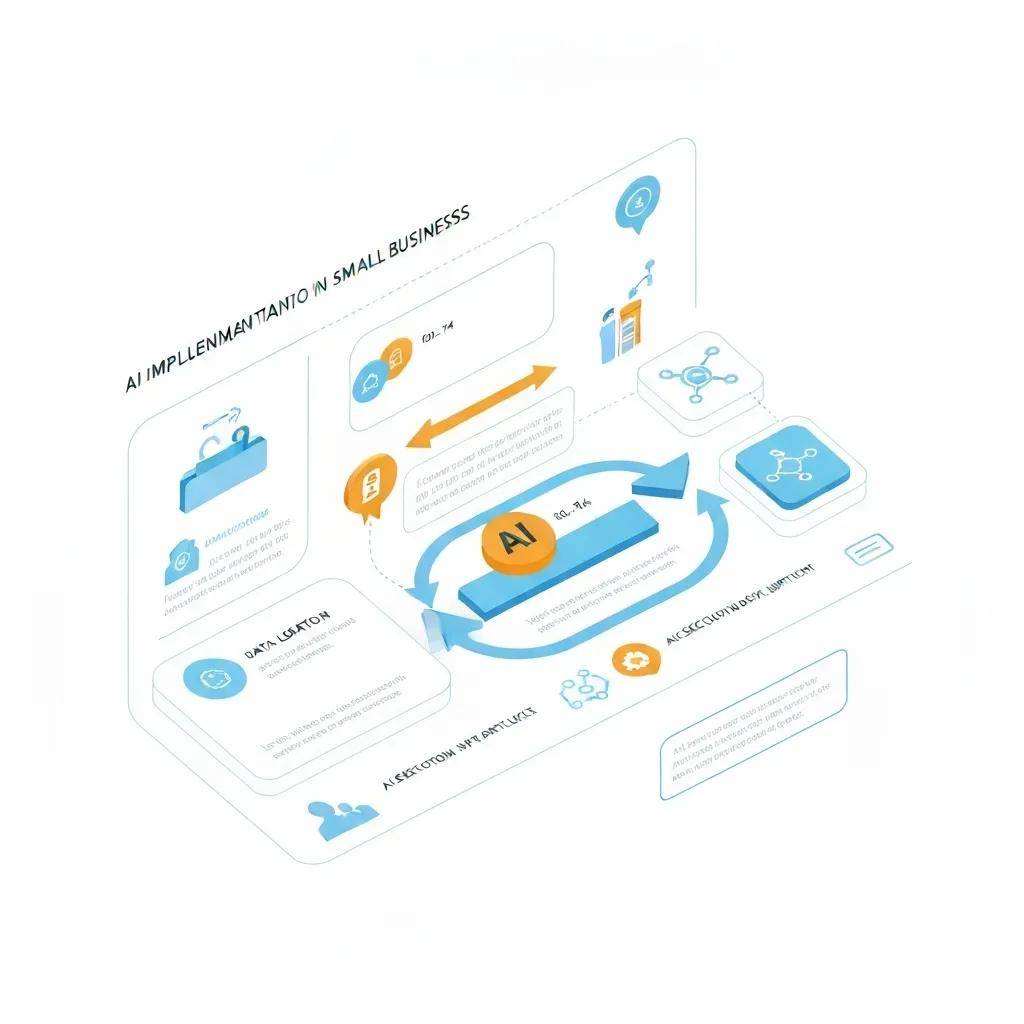Unlock the Power of AI: Strategies for Measurable SMB Growth
Over 98 percent of small and mid-sized businesses report using AI tools to enhance operations and growth—a clear sign that AI strategies drive tangible results for resource-constrained organizations.
This widespread adoption highlights the critical role that AI plays in refining business processes and decision-making capabilities. As organizations increasingly recognize the impact of AI on business strategy, they are adapting their approaches to leverage data-driven insights for competitive advantage. Ultimately, this trend paves the way for innovation, allowing these businesses to remain agile and responsive in an ever-evolving marketplace.
Decision-makers often struggle to align AI initiatives with business goals, risking wasted investments and fractured teams. This guide delivers a people-focused roadmap for leveraging AI for business growth, covering:
- Why AI is essential for SMB growth
- The key pillars of an effective AI strategy
- A practical AI implementation roadmap
- AI’s role in data-driven decision-making
- Boosting sales, marketing, and customer experience
- Data quality and analytics best practices
- Emerging AI trends and future-proofing
- Partnering with eMediaAI’s Deep Cognition Methodology
By weaving essential concepts with real-world examples and eMediaAI’s proven framework, you’ll gain a clear path to measurable impact without building an in-house AI team.
Why Is AI Essential for Small and Mid-Sized Business Growth?
AI combines automation, analytics, and machine learning to boost productivity, reduce costs, and sharpen competitive positioning for SMBs that lack large data science teams.
What Are the Key Benefits of AI in Business for SMBs?
AI improves operational efficiency, enhances decision-making, and drives customer satisfaction through data-driven insights and automated workflows.
Before reviewing use cases, consider these core advantages:
- Efficiency Gains – Automating repetitive tasks reduces manual errors and frees teams for strategic work.
- Cost Reduction – Predictive maintenance and demand forecasting lower inventory and downtime costs.
- Competitive Differentiation – Personalized customer interactions and rapid innovation set SMBs apart.
- Scalable Insights – Machine learning models uncover patterns in small-scale data that guide growth.
These benefits establish the foundation for deeper strategic AI adoption and inform how SMBs can translate technology into measurable business impact.
How Are SMBs Adopting AI Today?
SMBs adopt AI through off-the-shelf tools, cloud platforms, and consulting services, with 77 percent exploring or integrating AI into operations. Common adoption pathways include:
- Embedding chatbots and virtual assistants in customer service
- Using machine-learning-powered analytics for sales forecasting
- Automating marketing workflows with AI-driven personalization
- Leveraging AI-enabled financial tools for accounting and fraud detection
Early adopters report productivity growth of up to 1.5 percentage points annually, demonstrating that even modest pilots can yield significant ROI.
How Does AI Provide a Competitive Advantage for Small Businesses?
AI drives competitive advantage by enabling data-driven differentiation and rapid response to market shifts. When AI models analyze customer behavior and operational metrics, SMBs can:
- Tailor offerings based on real-time insights
- Optimize pricing through dynamic algorithms
- Accelerate product development with predictive trend analysis
By harnessing AI’s predictive power, lean organizations achieve the kind of agility and personalization once reserved for larger enterprises, strengthening market positioning and customer loyalty.
What Are the Key Pillars of an Effective AI Business Strategy?
An impactful AI strategy rests on aligned objectives, robust data foundations, the right technology, skilled talent, and ethical governance to ensure sustainable growth.
How Do You Define Clear Objectives for AI Strategy Development?
Defining objectives begins with pinpointing business goals—such as boosting lead generation by 20 percent or reducing support response times by half—and linking each goal to measurable AI outcomes.
- Identify core pain points and success metrics
- Map existing processes and data sources to objectives
- Set phased milestones for pilot, scale, and optimization
Objective clarity ensures AI investments drive the specific business impact SMB leaders require.
Why Is Data Strategy and Quality Crucial for AI Success?
High-quality, governed data serves as the lifeblood of AI models. Poor data quality undermines model reliability and skews insights.
Consider this comparison:
| Data Dimension | Impact on AI | Best Practice |
|---|---|---|
| Completeness | Incomplete records impair model accuracy | Regular data audits and enrichment |
| Consistency | Inconsistent formats confuse training | Standardize schemas across systems |
| Validity | Invalid entries produce skewed predictions | Implement validation rules at data entry |
| Timeliness | Stale data undercuts real-time insights | Automate data pipelines for frequent updates |
Robust data governance and quality controls create the reliable foundation needed for predictive analytics to deliver business value.
How to Select the Right AI Technologies and Infrastructure?
Choosing AI solutions involves evaluating functionality, scalability, and cost to fit SMB constraints:
| Solution Category | Key Attribute | Value for SMBs |
|---|---|---|
| Cloud AI Platforms | Pay-as-you-go scalability | Eliminates large upfront infrastructure costs |
| Pretrained Models | Rapid deployment | Speeds time-to-insight for common use cases |
| Low-Code/No-Code Tools | Ease of use | Empowers business users without deep technical expertise |
| Open Source Libraries | Customization flexibility | Enables tailored solutions with minimal licensing fees |
Selecting the right blend of cloud services, prebuilt components, and customization options ensures that technology investments align with both budget and business impact goals.
How Can SMBs Address Talent and Training Needs for AI?
SMBs bridge skill gaps by combining external expertise with internal upskilling programs:
- Partner with Specialists – Engage AI consultants who deliver blueprints and initial models.
- Upskill Existing Staff – Offer targeted training on data literacy and AI toolkits.
- Adopt Collaborative Platforms – Use no-code AI interfaces that reduce coding requirements.
- Foster a Data-Driven Culture – Embed AI champions within departments to lead adoption.
Blending external guidance with internal capability building accelerates sustainable AI proficiency across the organization.
What Are Ethical AI and Governance Considerations for SMBs?
Responsible AI governance safeguards fairness, privacy, and compliance. Key considerations include:
- Bias Mitigation – Regular audits of model outcomes to detect and correct biases
- Data Privacy – Encryption, anonymization, and user consent management
- Transparency – Documenting data sources, model logic, and decision rationale
- Regulatory Compliance – Aligning with GDPR, CCPA, and industry-specific mandates
Embedding ethical guardrails ensures AI strategies not only drive impact but also maintain trust and legal integrity.
How Can SMBs Implement AI to Drive Business Impact?
A phased implementation roadmap transforms AI from pilot to production, ensuring measurable outcomes at each stage.
What Is the Step-by-Step AI Implementation Roadmap for SMBs?

A structured approach reduces risk and maximizes ROI:
- Assessment & Discovery – Audit current processes, data assets, and technology gaps.
- Proof of Concept – Launch a focused pilot targeting a high-value use case.
- Evaluation & Optimization – Measure pilot results, refine models, and validate business impact.
- Scaling & Integration – Extend AI solutions across departments and integrate with core systems.
- Continuous Improvement – Monitor performance, retrain models, and incorporate new data sources.
This phased pathway ensures SMBs build confidence and expertise while steadily expanding AI-driven capabilities.
How to Measure ROI and Business Outcomes from AI Projects?
Tracking success requires both quantitative and qualitative metrics:
| Metric Category | Example KPI | Measurement Approach |
|---|---|---|
| Financial Impact | Cost savings, revenue uplift | Compare pre- and post-implementation data |
| Operational Efficiency | Task completion time reduction | Time-tracking analytics |
| Customer Experience | Net Promoter Score improvements | Surveys and sentiment analysis |
| Model Performance | Accuracy, precision, recall | Model evaluation reports |
Quantifying both business outcomes and model health creates a holistic view of AI’s return on investment.
What Are Common AI Adoption Challenges for SMBs and How to Overcome Them?
SMBs often face barriers such as limited budgets, data silos, and change resistance. Overcoming tactics include:
Challenge: Budget ConstraintsLeverage cloud-based, pay-per-use AI services to minimize upfront costs.
Challenge: Data FragmentationConsolidate data through integrated platforms and enforce governance practices.
Challenge: Cultural ResistanceCommunicate quick wins, involve stakeholders early, and demonstrate impact through pilot successes.
By targeting each obstacle with tailored solutions, SMBs can sustain momentum and build organizational buy-in.
How Does eMediaAI’s Deep Cognition Methodology Support AI Implementation?
eMediaAI’s proprietary Deep Cognition Methodology structures AI adoption into clear, outcome-focused phases.
- Discovery Workshops align AI projects with business goals and data readiness.
- Rapid Prototyping delivers working models within weeks to showcase immediate value.
- Iterative Scaling ensures continuous monitoring, model retraining, and ROI optimization.
This people-first framework empowers SMBs to implement AI strategically, minimizing risk and accelerating measurable results.
How Does AI Enhance Strategic Decision-Making in Small Businesses?
AI enriches decision processes by surfacing predictive insights, optimizing resource allocation, and revealing competitive intelligence.
What Role Does Predictive Analytics Play in Business Intelligence?
Predictive analytics uses historical data and machine learning to forecast trends and guide proactive decisions.
- Sales Forecasting – Anticipates demand fluctuations for inventory planning.
- Churn Prediction – Identifies at-risk customers to prioritize retention efforts.
- Financial Modeling – Projects cash flow scenarios under varying market conditions.
By injecting forward-looking insights into dashboards, SMB leaders gain the confidence to act swiftly and strategically.
How Can AI Improve Risk Management and Resource Allocation?
AI algorithms evaluate risk factors—such as supplier reliability, creditworthiness, and operational bottlenecks—to optimize resource distribution.
- Risk Scoring Models assign probability metrics to potential disruptions.
- Automated Alerts notify decision-makers when key indicators deviate.
- Scenario Analysis tests resource scenarios under different market conditions.
This proactive approach reduces uncertainty and aligns investments with areas of greatest impact.
How Does AI Support Market Analysis and Competitive Intelligence?
AI tools mine public data, customer feedback, and social media to reveal emerging market trends and competitor moves.
- Sentiment Analysis – Gauges brand perception against industry benchmarks.
- Trend Detection – Discovers rising topics and product features with natural language processing.
- Competitive Monitoring – Tracks pricing, promotions, and new product launches using automated web scraping.
These insights enable SMBs to adapt offerings, refine messaging, and seize new market opportunities.
How Can AI Boost Sales, Marketing, and Customer Experience for SMBs?
AI empowers SMBs to personalize outreach, forecast sales accurately, and deliver responsive customer experiences at scale.
How Does AI Drive Lead Generation and Targeted Marketing Campaigns?
AI enhances lead generation by segmenting audiences and automating outreach workflows:
- Behavioral Scoring ranks prospects based on engagement patterns.
- Personalized Content tailors emails and ads to individual interests.
- Dynamic Campaign Optimization adjusts bids and targeting in real time for highest ROI.
These capabilities boost conversion rates and reduce customer acquisition costs.
What Are the Benefits of AI-Powered Sales Forecasting?
AI-driven forecasting improves accuracy by 20 to 50 percent, enabling better inventory and staffing decisions:
- Incorporates external variables (seasonality, market indicators) for more reliable projections.
- Updates forecasts continuously as new data arrives.
- Flags anomalies for rapid investigation, reducing stockouts and overstock risks.
Enhanced forecasting directly translates into increased revenue and reduced operational waste.
How Can AI Enhance Customer Experience Through Chatbots and Personalization?
AI-powered chatbots and recommendation engines create seamless, personalized interactions:
| Feature | Mechanism | Benefit |
|---|---|---|
| Conversational Chatbots | NLP-driven dialogue flows | 24/7 customer support with human-like tone |
| Recommendation Engines | Collaborative filtering and behavioral data | Tailored product suggestions that boost sales |
| Sentiment-Adaptive Routing | Real-time sentiment analysis | Escalates critical issues to human agents promptly |
By combining automation with personalized engagement, SMBs deliver exceptional experiences that foster loyalty and repeat business.
What Data Quality and Analytics Practices Ensure AI Success in SMBs?
Data quality and strategic analytics underpin the reliability and impact of any AI initiative.
How to Establish Robust Data Governance and Management?

Robust governance defines clear roles, policies, and workflows for data ownership and quality control:
- Data Stewardship Roles – Assign accountability for data standards and access.
- Metadata Catalogs – Maintain an inventory of data sources, formats, and usage guidelines.
- Automated Quality Checks – Enforce validation rules during ingestion and transformation.
- Access Controls – Implement role-based permissions to secure sensitive information.
Effective governance ensures data integrity and streamlines compliance, enabling AI solutions to deliver trusted insights.
Why Is Data Analytics Foundational for AI-Driven Business Growth?
Advanced analytics transforms raw data into actionable intelligence that fuels AI models:
- Descriptive Analytics reveals what happened through dashboards and reports.
- Diagnostic Analytics uncovers why events occurred via root-cause exploration.
- Prescriptive Analytics recommends optimal actions using optimization algorithms.
This multi-layered analytics approach ensures AI use cases rest on deep understanding, not just black-box predictions.
How Can SMBs Leverage Business Intelligence Tools Effectively?
BI tools empower teams to visualize trends, drill into metrics, and share insights across the organization:
| Tool Type | Capability | SMB Advantage |
|---|---|---|
| Cloud Dashboards | Real-time data blending | Immediate visibility into key performance indicators |
| Embedded Analytics | In-application reporting | Contextual insights within operational workflows |
| Mobile BI | On-the-go access | Decision support for field and remote teams |
Selecting BI platforms that integrate seamlessly with existing data sources accelerates adoption and democratizes insights for every stakeholder.
What Is the Future of AI for Small and Mid-Sized Businesses?
Emerging AI advancements promise to extend impact across operations, innovation, and ethics—reshaping how SMBs compete and collaborate.
How Will Generative AI and Agentic AI Transform SMB Operations?
Generative AI and autonomous AI agents will automate complex creative and decision tasks:
- Generative Content Creation – Producing marketing copy, product designs, and code snippets on demand.
- Agentic Workflow Orchestration – Autonomous agents coordinate multi-step processes from data gathering to execution.
- Adaptive Learning Systems – Models that self-optimize based on live performance feedback.
These capabilities will unlock new productivity frontiers and redefine resource allocation for SMBs.
What Ethical and Governance Challenges Will SMBs Face Moving Forward?
As AI capabilities grow, organizations must address issues of accountability, transparency, and societal impact:
- Explainability Requirements – Providing clear rationales for automated decisions.
- Bias and Fairness Audits – Ensuring models treat diverse groups equitably.
- Data Sovereignty – Respecting jurisdictional data residency and privacy standards.
Proactive governance frameworks will become essential to balance innovation with responsibility.
How Can SMBs Prepare for Long-Term AI Adoption and Innovation?
Sustained AI maturity depends on strategic planning, continuous learning, and ecosystem partnerships:
- Roadmap Refresh Cycles – Regularly update AI roadmaps based on new technologies and results.
- Innovation Labs – Pilot emerging AI use cases in controlled environments.
- Ecosystem Engagement – Collaborate with academic institutions, technology partners, and industry consortia.
- Change Management Programs – Embed AI literacy and best practices into organizational culture.
By institutionalizing AI governance and experimentation, SMBs lay the groundwork for enduring competitive advantage.
Why Partner with eMediaAI for AI Strategy Consulting and Implementation?
eMediaAI specializes in delivering tailored AI roadmaps and hands-on support that empower SMBs to achieve measurable outcomes without building full in-house teams.
What Makes eMediaAI’s AI Strategy Consulting Tailored for SMBs?
eMediaAI combines deep technical expertise with a people-first approach:
- SMB-Focused Frameworks align projects to resource realities and growth objectives.
- Cross-Functional Workshops ensure stakeholder alignment and rapid knowledge transfer.
- Modular Service Offerings allow businesses to engage at the pilot, scale, or optimization phase as needed.
This customized approach delivers maximum impact for organizations with 10–500 employees and limited AI resources.
How Does the Deep Cognition Methodology Deliver Measurable Business Impact?
The Deep Cognition Methodology anchors every engagement in clear outcomes and continuous improvement:
| Phase | Feature | Impact |
|---|---|---|
| Discovery & Alignment | Business goal mapping | Ensures AI projects address top priorities |
| Rapid Prototyping | Minimum viable AI models | Demonstrates quick wins and builds confidence |
| Performance Optimization | Ongoing model retraining and tuning | Maximizes ROI through continuous learning |
This structured, iterative model accelerates time-to-value while maintaining alignment with evolving business needs.
What Are Some Client Success Stories Demonstrating AI Benefits?
Manufacturing SMBs, professional services firms, and e-commerce retailers have realized measurable gains through eMediaAI partnerships:
- A 75-person manufacturer cut downtime by 20 percent through predictive maintenance modeling.
- A regional retailer increased online sales by 30 percent via AI-driven personalization engines.
- A professional services firm reduced proposal preparation time by 50 percent using generative AI document automation.
These outcomes showcase how eMediaAI’s people-first strategies translate AI into quantifiable growth and efficiency.
eMediaAI’s expertise, combined with its Deep Cognition Methodology, enables SMB leaders to adopt AI responsibly and effectively—unlocking productivity gains, competitive differentiation, and data-driven decision-making without the burden of building a full in-house AI team.
AI strategies, when aligned to clear objectives, robust data practices, and ethical governance, empower SMBs to operate at enterprise scale. Implementing a phased roadmap and measuring outcomes ensures that every AI initiative delivers quantifiable value. By partnering with eMediaAI, organizations gain access to tailored frameworks, expert guidance, and proven methodologies proven to enhance efficiency, boost revenues, and strengthen customer experiences. The future of SMB growth lies in strategic, responsible AI adoption—today’s pilots lay the groundwork for tomorrow’s innovation and sustained competitive advantage.






